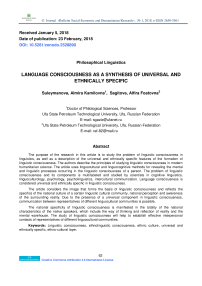Language Consciousness as a Synthesis of Universal and Ethnically Specific
Автор: Suleymanova Almira Kamilovna, Sagitova Alfira Foatovna
Журнал: Bulletin Social-Economic and Humanitarian Research @bulletensocial
Статья в выпуске: 1 (1), 2018 года.
Бесплатный доступ
The purpose of the research in this article is to study the problem of linguistic consciousness in linguistics, as well as a description of the universal and ethnically specific features of the formation of linguistic consciousness. The authors describe the principles of studying linguistic consciousness in modern humanitarian science. The article uses linguocultural and linguocognitive methods for revealing the mental and linguistic processes occurring in the linguistic consciousness of a person. The problem of linguistic consciousness and its components is multifaceted and studied by scientists in cognitive linguistics, linguoculturology, psychology, psycholinguistics, intercultural communication. Language consciousness is considered universal and ethnically specific in linguistic consciousness. The article considers the image that forms the basis of linguistic consciousness and reflects the specifics of the national culture of a certain linguistic cultural community, national perception and awareness of the surrounding reality. Due to the presence of a universal component in linguistic consciousness, communication between representatives of different linguocultural communities is possible. The national specificity of linguistic consciousness is manifested in the totality of the national characteristics of the native speakers, which include the way of thinking and reflection of reality and the mental warehouse. The study of linguistic consciousness will help to establish effective interpersonal contacts of representatives of different linguocultural communities.
Linguistic consciousness, ethnolinguistic consciousness, ethnic culture, universal and ethnically specific, ethno-cultural layer
Короткий адрес: https://sciup.org/14114652
IDR: 14114652 | DOI: 10.5281/zenodo.2528890


